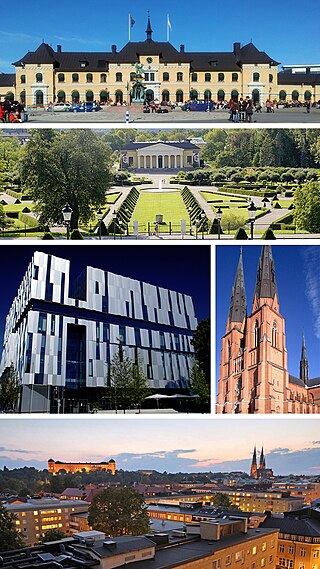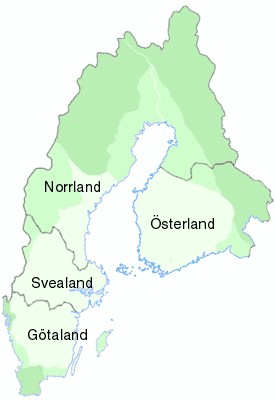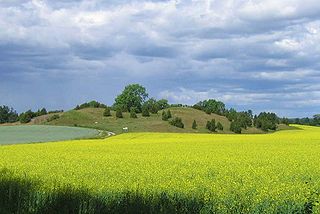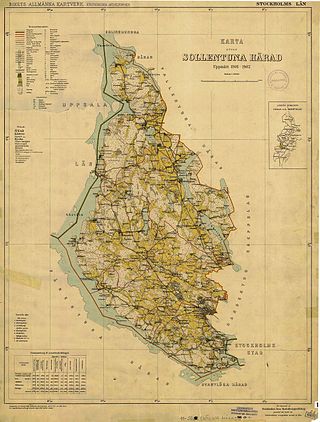
Roslagen is the name of the coastal areas of Uppland province in Sweden, which also constitutes the northern part of the Stockholm archipelago.

Uppsala is the county seat of Uppsala County and the fourth-largest city in Sweden, after Stockholm, Gothenburg, and Malmö. It had 177,074 inhabitants in 2019.

Sollentuna Municipality is a municipality in Stockholm County in east-central Sweden, north of Stockholm. Its seat of local government is located in Tureberg, which is a part of Sollentuna urban area.

Uppland is a historical province or landskap on the eastern coast of Sweden, just north of Stockholm, the capital. It borders Södermanland, Västmanland and Gästrikland. It is also bounded by lake Mälaren and the Baltic Sea. On the small uninhabited island of Märket in the Baltic, Uppland has a very short and unusually shaped land border with Åland, an autonomous province of Finland.

Svealand, or Swealand, is the historical core region of Sweden. It is located in south central Sweden and is one of three historical lands of Sweden, bounded to the north by Norrland and to the south by Götaland. Deep forests, Tiveden, Tylöskog, and Kolmården, separated Svealand from Götaland. Historically, its inhabitants were called Svear, from which is derived the English 'Swedes'.

A thing, also known as a folkmoot, assembly, tribal council, and by other names, was a governing assembly in early Germanic society, made up of the free people of the community presided over by a lawspeaker. Things took place at regular intervals, usually at prominent places that were accessible by travel. They provided legislative functions, as well as being social events and opportunities for trade. In modern usage, the meaning of this word in English and other languages has shifted to mean not just an assemblage of some sort but simply an object of any sort.

Swedish pre-history ends around 800 AD, when the Viking Age begins and written sources are available. The Viking Age lasted until the mid-11th century. Scandinavia was formally Christianized by 1100 AD. The period 1050 to 1350—when the Black Death struck Europe—is considered the Older Middle Ages. The Kalmar Union between the Scandinavian countries was established in 1397 and lasted until King Gustav Vasa ended it upon seizing power. The period 1350 to 1523 – when king Gustav Vasa, who led the unification of Sweden in the Swedish War of Liberation, was crowned – is considered the Younger Middle Ages. During these centuries, Sweden gradually consolidated as a single nation.

Ingjald illråde or Ingjaldr hinn illráði was a semi-legendary Swedish king of the House of Ynglings, son and successor of King Anund, and the father and predecessor of King Olof Trätälja. As with many of the 5th-7th century Yngling Kings of Sweden, his historicity is contested.

Valsgärde or Vallsgärde is a farm on the Fyris river, about three kilometres north of Gamla Uppsala, the ancient centre of the Swedish kings and of the pagan faith in Sweden. The present farm dates from the 16th century. The farm's notability derives from the presence of a burial site from the Swedish Vendel Age ; it was used for more than 300 years. The first ship burial is from the 6th century and the last graves are from the 11th century.

Sollentuna Hundred was a hundred of Uppland in Sweden. It encompassed the present-day municipalities of Järfälla, Sollentuna, and Sundbyberg as well as parts of Upplands Väsby Municipality and Stockholm. All are now part of Stockholm County. The hundred had three köpingar—Sollentuna Köping, Sundbybergs Köping, and Hässelby Villastads Köping—and a number of municipalsamhällen. Most of the hundred is now part of the urban area of Stockholm, but the larger part of in the remainder is in Upplands Väsby. The total area was around 197 km2 and the population in 1916 was 20,727 people.

Fjärdhundraland or the land of the four hundreds is, since 1296, a part of the province of Uppland in Sweden. Its name refers to its role of providing 400 men and 16 ships for the leidang of the Swedish king at Uppsala.

Tiundaland is a historic region, Folkland, and since 1296 part of the modern province of Uppland. It originally meant the land of the ten hundreds and referred to its duty of providing 1000 men and 40 ships for the Swedish king's leidang.

The Stones of Mora is a historic location in Knivsta, Sweden. Several Medieval kings of Sweden were proclaimed at the assembly of Mora near modern Uppsala. It was moved in the 15th century and was considered to have been lost. However, there are a number of stones of record in a small building in the vicinity of the former assembly site.

Torgny the Lawspeaker is the name of one of at least three generations of lawspeakers by the name Þorgnýr, who appear in the Heimskringla by the Icelandic scholar and chieftain Snorri Sturluson, and in the less known Styrbjarnar þáttr Svíakappa and Hróa þáttr heimska. They were the lawspeakers of Tiundaland, and all lawspeakers in the Swedish kingdom were their subordinates.

The Diocese of Stockholm is a division of the Church of Sweden. Its cathedral is Storkyrkan in Stockholm's Old Town. The diocese covers most of metropolitan Stockholm and was formed in 1942 from parts of the medieval dioceses of Strängnäs and Uppsala, both of which pre-dated the foundation of the city. Before 1942, the City of Stockholm itself and Greater Stockholm were divided more or less equally between the two medieval dioceses at Slussen just south of Stockholm's Old Town.

The Kurki family or Kurck, also known as the family of Laukko, is a medievally-originated Finnish noble family that produced several historically prominent persons. It is documented in the late 14th century. The family is usually divided in several lineages as it continued through female succession.

Sollentuna socken is a former socken of Sollentuna Hundred in Uppland, Sweden. The area largely corresponds to the modern Sollentuna Municipality, but not completely. Hansta was incorporated into Stockholm Municipality in 1980, while other localities were incorporated into the municipality from other parishes.

Sollentuna is one of the five stations of the Stockholm commuter rail in Sollentuna Municipality. It is situated in the neighbourhood of Tureberg 13.3 km north of Stockholm Central Station. The station was originally called Tureberg and was opened in 1866 in a rural setting along the railway Stockholm–Uppsala. The name was changed to Sollentuna in 1968 at the request of the municipality, since Tureberg is the de facto centre of the municipality. The area around the station has developed into a suburban centre with high rise buildings, a bus terminal and a large shopping mall.

Tureberg is a neighbourhood in Sollentuna Municipality, Stockholm County, Sweden with 18,866 inhabitants (2018). It is a Stockholm suburb and houses the seat of local government for the municipality as well as a large shopping mall and a Stockholm commuter rail station.
The Law of Uppland was the law that applied in Uppland, Sweden, from 1296 to the beginning of the 1350s.
















